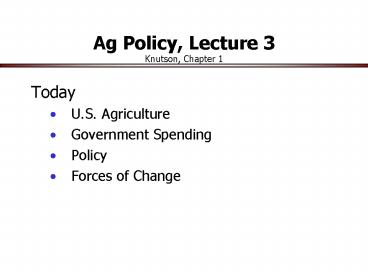Ag Policy, Lecture 3 Knutson, Chapter 1 - PowerPoint PPT Presentation
1 / 22
Title:
Ag Policy, Lecture 3 Knutson, Chapter 1
Description:
How big a player is U.S. agriculture in the world? How much money does the U.S. spend on agriculture? ... Politics. Political process makes farm policy and ... – PowerPoint PPT presentation
Number of Views:236
Avg rating:3.0/5.0
Title: Ag Policy, Lecture 3 Knutson, Chapter 1
1
Ag Policy, Lecture 3 Knutson, Chapter 1
- Today
- U.S. Agriculture
- Government Spending
- Policy
- Forces of Change
2
Setting the Stage
- How much does agriculture matter to the U.S.
economy? - How big a player is U.S. agriculture in the
world? - How much money does the U.S. spend on
agriculture?
3
How Big a Player is U.S. Agriculture in the World?
- 1 exporter of ag products in the world
- Over 30 of crop acreage basically for export
- What does this mean for policy?
4
How much does Agriculture Matter to the U.S.
economy?
- Depends
- Farming accounts for 1 of workforce and less
than 1 of GDP - Entire food and fiber system accounts for 17 of
workforce and 13 of GDP
5
How Much Money Does the U.S. Spend on Agriculture?
- What do you call agriculture?
- Do you define it by what Ag committees have
responsibility for?
6
Allocation of U.S. Budget Outlays by Function, FY
2001
Human Resources includes health, medicare,
social security, etc. Physical Resources
includes transportation, community and regional
development, etc. Source Budget of the U.S.
Government www.whitehouse.gov/omb/budget/fy2003/pd
f/hist.pdf
7
Share of Mandatory Program Spending by Farm Bill
Title Budget Authority, FY 2002-2011.
782 Billion Total
Does not include funding for discretionary
programs which is provided through annual
appropriations. Based on CBOs March 2002
Baseline.
8
Policy
- Definition Guiding principle leading to course
of action or specific program pursued by
governments - Programs implement policy
- Example
- Policy -- Pursuit of freer trade
- Programs NAFTA, FTAA
9
Agricultural and Food Policy
- Principles that guide government programs that
influence - Production
- Resources used
- Domestic and international markets
- Food consumption
- Conditions under whichrural people live
10
Ag Food Policy is broader than the programs
that support farm prices and/or incomes
- Retirement of fragile land from production (CRP)
- Negotiation to reduce barriers to trade (WTO)
- Water allocation, development and pricing
- Food safety and terrorism
- Child nutrition (WIC)
11
Policies and programs are constantly changing
Forces of Change
- Instability of agriculture
- Globalization
- Technology
- Food safety
- Environment
- Industrialization
- Politics
- Unforeseen events
12
Instability of Agriculture
- Inelastic demand and supply
- 1 percent change in quantity supplied causes
more than 1 change in price - Supply unstable due to
- Weather and insects affect yields
- Response to inputs is uncertain
- Lag in production response
- Demand is also unstable due to production in the
rest of the world - Export demand changes from year to year causing
total demand to shift in and out
S0
S1
D
Q/Yr
13
Globalization of Markets
- Increased interdependence of markets, cultures,
economies, and political systems - US Ag. depends on exports to support its
investments in land and machinery - US Ag. exports depend on market access
- Trade must flow both ways
14
Technology
- Technology is provided to agriculture by business
and Ag. Universities - Technology introduced in lumps
- Farmers must adopt new technology or fall behind
- Tread mill effect holds that technology drives
down prices, farmers must adopt next tech. which
drives down prices - Who benefits from technology?
15
Food Safety
- Concerns about E. coli in hamburger, Salmonella
in poultry, Listeria in dairy products, and now
BSE in beef - Pesticide bans if carcinogenic in test animals
- Terrorist threats on food supply
- Food safety extends to environmental safety
issues for soil, air, and water - Hormones in beef and GMOs are food safety issues
in Europe and affects US exports
16
Environment
- Food Safety
- Biotechnology
- Imports
- Water/Air Quality
- Confined Animal Operations
- Chemical Use
- Conservation
- Land, Water, Endangered Species
- Environmental Issues Trade Policy
17
Industrialization
- Modern agriculture depends on purchased inputs
seed, herbicides, insecticides, fertilizer,
labor, fuel, equipment, etc. - Structure of farming has changed small to large
farms - More importance placed on the entire supply chain
- Affects on rural communities
18
Politics
- Political process makes farm policy and passes
the farm programs - A myth is that the declining rural population has
led to less political influence by farmers - Operating as a minority has led to different
approaches - Coalition building on particular issues
- Agriculture has political diversity, able to
function with a different party in power
19
Unforeseen Events
- Terrorism
- BSE
20
Rational for Government Involvement in
Agriculture
- Farm Financial Health
- Price and Income Support
- Price and Income Instability
- Abundant/Cheap Food Supply
- Food Security
- Food Safety
- Poverty
- Market Externalities
- Environment
- Other Public Concerns
21
Constraints on Government Involvement in
Agriculture
- Economic Freedom
- Political Conservatism
- Government Costs
- Capitalization
- Globalization
- Common Sense
22
Lecture 3, Wrap up
- U.S. Agriculture (How important is Agriculture?)
- Government Spending (What is spent on
Agriculture?) - Policy
- You should be able to define and discuss the
differences between policies and programs, and
provide an example - Forces of Change
- You should be able to discuss intelligently any
of the 8 categories of forces - Government Involvement
- Rationale
- Constraints
- Next Class, Policy Process
- Chapter 3































